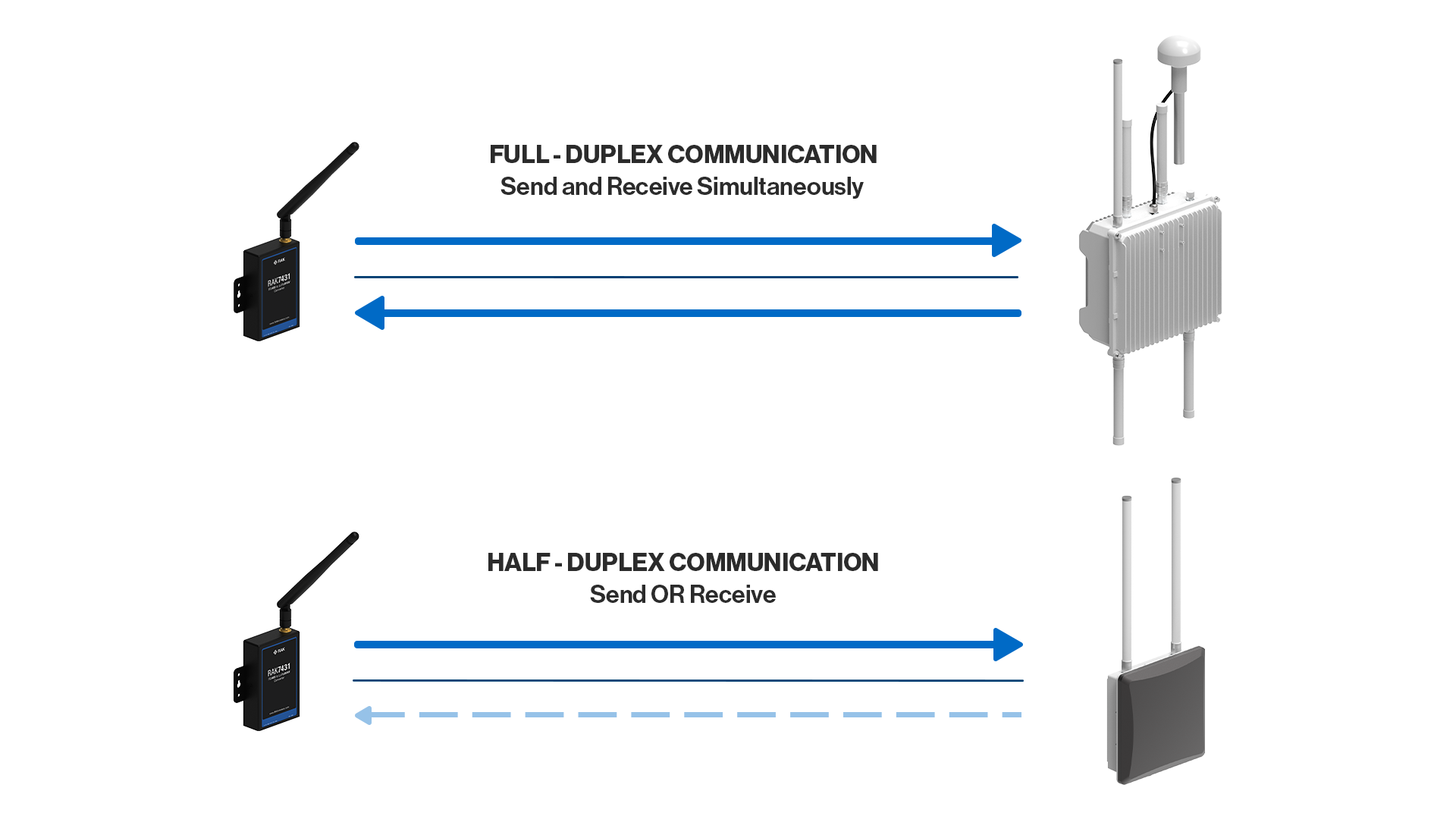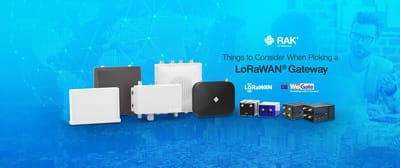Optimizing Data Exchange: Half-Duplex vs. Full-Duplex Communication in LoRaWAN® Deployments
The modes of data transmission play a pivotal role in shaping the efficiency and effectiveness of various systems. Among these modes, understanding the distinctions between half-duplex and full-duplex communication is paramount. Comprehending these concepts is essential for optimizing the performance of technologies across diverse applications.
With LoRaWAN networks increasingly relied upon for long-range, low-power IoT applications, the choice between half-duplex and full-duplex communication can significantly impact the performance and scalability of the system.
Half-Duplex Communication
Half-duplex communication, a mode widely employed in various technological systems, exhibits distinct characteristics and functionalities.
Definition and Characteristics
Half-duplex communication enables bidirectional data exchange but restricts simultaneous transmission and reception. Devices can either send or receive data at any given time, but not both concurrently. Think of it as a walkie-talkie scenario, where one party must finish transmitting before the other can respond.
In the context of LoRaWAN, this mode enables gateways to alternate between sending and receiving data packets from end devices, ensuring efficient utilization of the communication channel.
Examples of Usage
Half-duplex communication finds application in scenarios where real-time, bidirectional communication is not required simultaneously. Common examples include:
- Walkie-talkies: Users must press a button to transmit their message, while the device remains in a listening mode when not transmitting.
- Traditional telephone lines: Before the advent of modern telecommunications technology, traditional phone lines operated in half-duplex mode, allowing users to converse by taking turns speaking and listening.
Half-duplex communication is commonly employed in LoRaWAN networks for applications where periodic data exchange suffices. For instance, in environmental monitoring or asset tracking scenarios, LoRaWAN gateways in half-duplex mode can efficiently manage intermittent data transmissions from end devices.
Explanation of Operation
In half-duplex communication, devices alternate between sending and receiving data packets. When a device transmits data, it temporarily switches to a receiving state after completing transmission, awaiting incoming data from the other communicating party.
Same for LoRaWAN gateways. They alternate between transmitting downlink data (from the network server to end devices) and receiving uplink data (from end devices to the network server). This sequential communication enables bidirectional data exchange, albeit in one direction at a time, ensuring effective communication with end devices.
Advantages and Disadvantages
|
Advantages |
Disadvantages |
|
Simplicity of implementation |
Reduced throughput compared to full-duplex |
|
Lower cost and complexity of hardware |
Increased latency due to alternating transmission |
|
Well-suited for applications with periodic data exchange |
Limited scalability for high-volume data transfer |
|
Lower power consumption for gateway devices |
|
Full-Duplex Communication
Full-duplex communication is a significant innovation in modern technology, allowing for simultaneous bidirectional data transmission with unique characteristics and functionalities.
Definition and Characteristics
Unlike half-duplex communication, full-duplex communication allows devices to both transmit and receive data concurrently. This mode enables seamless two-way communication without the need for pauses or alternating transmission cycles.
In the context of LoRaWAN gateways, supporting full-duplex functionality enhances the throughput and responsiveness of the system, enabling them to simultaneously transmit data to end devices and receive data from them, optimizing the efficiency and responsiveness of the network.
Examples of Usage
Full-duplex communication is prevalent in a wide array of modern networking technologies, including Ethernet and Wi-Fi, where devices can both send and receive data concurrently. Additionally, cell phones leverage full-duplex communication to enable users to engage in real-time conversations without interruption.
In LoRaWAN deployments, gateways can efficiently manage bidirectional communication with numerous end devices spread across a wide area. This ensures seamless data exchange for applications such as smart cities, agriculture, and industrial IoT.
Explanation of Operation
Full-duplex operation in LoRaWAN gateways allows them to transmit downlink data (from the network server to end devices) while simultaneously receiving uplink data (from end devices to the network server). This simultaneous communication enhances network throughput and responsiveness, enabling real-time monitoring and control of IoT devices. This mode of operation is achieved through sophisticated hardware and protocol designs, allowing for continuous bidirectional data flow.
Advantages and Disadvantages
|
Advantages |
Disadvantages |
|
Enhanced throughput, network efficiency, and scalability |
Higher hardware and implementation costs |
|
Reduced latency due to simultaneous bidirectional data transmission |
Complexity in managing simultaneous data streams |
|
Ideal for real-time applications requiring continuous bidirectional communication |
Susceptibility to interference and signal degradation |
|
|
Potential increase in power consumption for gateway devices |

Comparison: Half-Duplex vs. Full-Duplex Communication in LoRaWAN Deployments
When considering communication modes for LoRaWAN deployments, comparing half-duplex and full-duplex communication reveals distinct advantages and considerations that shape their suitability for different scenarios.
Direct Comparison
Half-duplex communication allows bidirectional data exchange, though not simultaneously, while full-duplex communication enables simultaneous transmission and reception. This fundamental difference impacts factors such as throughput, latency, and complexity in LoRaWAN deployments.
Considerations
- Speed: Full-duplex communication typically offers higher throughput and reduced latency compared to half-duplex, enabling faster data exchange in LoRaWAN networks.
- Efficiency: Full-duplex communication optimizes channel utilization, enhancing network efficiency and scalability, whereas half-duplex may experience limitations in high-volume data transfer scenarios.
- Complexity: Implementing full-duplex communication may entail higher hardware and implementation costs, as well as increased complexity in managing simultaneous data streams, compared to the simplicity of half-duplex operation.
- Cost: Half-duplex communication may offer cost advantages in terms of hardware and implementation, making it an attractive option for applications with budget constraints.
Use Cases
- Half-Duplex: Suitable for LoRaWAN applications requiring intermittent data exchange or periodic sensor readings, such as environmental monitoring, agriculture, and asset tracking. The simplicity and lower power consumption of half-duplex operation make it well-suited for battery-powered end devices with limited communication requirements.
- Full-Duplex: Ideal for real-time applications demanding continuous bidirectional communication, such as smart city deployments, industrial IoT, and surveillance systems. Full-duplex communication enhances responsiveness and enables timely control and monitoring of IoT devices in LoRaWAN networks.
Challenges and Solutions in LoRaWAN Deployments
Implementing both half-duplex and full-duplex communication modes in LoRaWAN deployments presents unique challenges, along with innovative solutions and advancements tailored to address these issues effectively.
Challenges Associated with Each Mode
- Half-Duplex: The primary challenge with half-duplex communication in LoRaWAN deployments lies in its limited throughput and potential latency due to alternating transmission cycles. This can pose constraints, particularly in applications requiring continuous bidirectional communication or high-volume data transfer.
- Full-Duplex: Full-duplex communication may encounter challenges related to increased complexity in managing simultaneous data streams, as well as potential interference and collision in densely deployed LoRaWAN networks. Moreover, implementing full-duplex functionality may entail higher hardware and implementation costs.
Solutions and Workarounds
- Half-Duplex: To overcome the throughput and latency limitations of half-duplex communication in LoRaWAN deployments, optimizing data transmission protocols and implementing efficient data aggregation techniques can help minimize transmission overhead and enhance network efficiency. Additionally, deploying advanced error correction and packet retransmission mechanisms can mitigate the impact of packet loss and improve reliability.
- Full-Duplex: Addressing the complexity and interference challenges of full-duplex communication in LoRaWAN deployments requires careful network planning and optimization. Employing adaptive modulation and coding schemes, can mitigate interference and enhance network robustness. Furthermore, deploying advanced collision avoidance algorithms and channel access protocols can optimize channel utilization and minimize the risk of packet collisions in densely deployed environments.
Advancements in Technology
- Half-Duplex: Advancements in LoRaWAN technology, such as the introduction of adaptive data rate algorithms and dynamic channel allocation techniques, continuously improve the efficiency and reliability of half-duplex communication in LoRaWAN deployments. Additionally, advancements in low-power processing and signal processing capabilities enable more sophisticated error correction and data compression techniques, further enhancing the performance of half-duplex communication.
- Full-Duplex: Emerging technologies, such as cognitive radio and beamforming, offer promising solutions to address the complexity and interference challenges of full-duplex communication in LoRaWAN deployments. By leveraging cognitive radio techniques, LoRaWAN gateways can intelligently adapt their transmission parameters and frequency bands to mitigate interference and optimize channel utilization. Similarly, beamforming technologies enable directional communication, reducing the impact of interference and improving the signal-to-noise ratio in full-duplex communication scenarios.
Conclusion
In the dynamic landscape of IoT connectivity, the choice between half-duplex and full-duplex communication modes holds significant implications for the efficiency, reliability, and scalability of LoRaWAN deployments. Through this exploration, it becomes evident that both modes offer unique advantages and considerations, shaping their suitability for different applications and use cases.
Half-duplex communication, with its simplicity, lower cost, and well-suitedness for intermittent data exchange, remains a viable option for LoRaWAN deployments in scenarios where periodic sensor readings or occasional data transmissions suffice. However, its limitations in throughput and latency underscore the need for optimization and efficiency-enhancing techniques to maximize network performance.
On the other hand, full-duplex communication presents compelling advantages in terms of enhanced throughput, reduced latency, and continuous bidirectional communication capabilities, making it ideal for real-time applications and high-volume data transfer scenarios. Despite its complexity and potential cost implications, advancements in technology, such as cognitive radio and beamforming, offer promising solutions to address interference challenges and optimize network robustness.
Looking ahead, the future of LoRaWAN communication is shaped by evolving trends and emerging technologies that promise to redefine the way we connect and communicate in IoT deployments. Embracing these advancements, understanding the nuances of communication modes, and proactively addressing challenges are essential steps toward unlocking the full potential of LoRaWAN technology. By staying informed, leveraging best practices, and embracing innovation, we can navigate the evolving landscape of IoT connectivity, enabling transformative solutions that drive progress and innovation across industries.
Read more Understanding the Advantages and Limitations of LoRaWAN®





